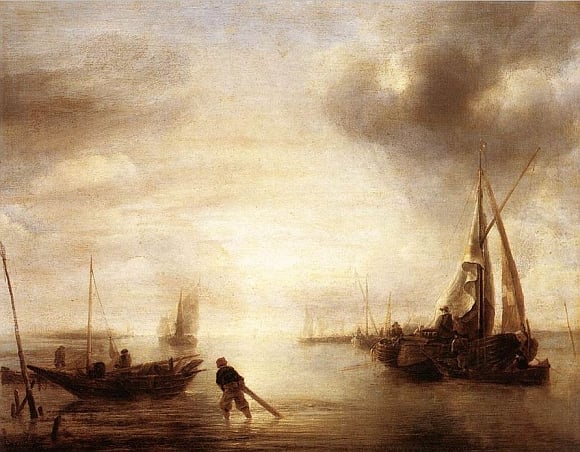
Meeresstille
Tiefe Stille herrscht im Wasser,
Ohne Regung ruht das Meer,
Und bekümmert sieht der Schiffer
Glatte Fläche ringsumher.
Keine Luft von keiner Seite!
Todesstille fürchterlich!
In der ungeheuern Weite
Reget keine Welle sich.
Glückliche Fahrt
Die Nebel zerreißen,
Der Himmel ist helle,
Und Äolus löset
Das ängstliche Band.
Es säuseln die Winde,
Es rührt sich der Schiffer.
Geschwinde! Geschwinde!
Es teilt sich die Welle,
Es naht sich die Ferne;
Schon seh’ ich das Land!
Quiet Sea
Deep quiet rules the waters;
motionless, the sea reposes,
and the boatsman looks about with alarm
at the smooth surfaces about him.
No wind comes from any direction!
A deathly, terrible quiet!
In the vast expanse
not one wave stirs.
Fortunate Voyage
The mist is torn away,
The heavens turn bright,
And Aeolus unfastens
The bonds of fear.
There, the winds rustle,
the boatsman stirs.
Quickly! Quickly!
The waves rise up again.
The distant view draws close,
Land ho, I call!
—Johann Wolfgang Goethe, “Meeresstille” and “Glückliche Fahrt” (1795) in Sämtliche Werke vol. 4.1, p. 666 (K. Richter ed. 1988)(S.H. transl.)
These two short poems were composed at least as early as 1795, when Schiller published them, though perhaps a bit earlier. They were clearly intended as a pairing, and they consistently appeared published together during Goethe’s lifetime. The image they present is an unusual one, but highly evocative of the thinking of the early Romantic period. Normally we would associate danger at sea with a violent storm. But Goethe points to just the opposite: complete quiet. For a ship stuck in a listless latitude, the absence of wind could be every bit as threatening as a storm, though also combined with a greater measure of mystery. The image that Goethe presents is a masterful study in contradictions: the utter peace of the motionless sea provokes fear and alarm. But the fear associated with the calm sea gives way to joy as a mist is dispelled and the wind kicks up. The tension is finally dispelled when land is sighted. The poem gives life to the ideas about nature that Edmund Burke brought to paper in A Philosophical Enquiry into the Origin of Our Ideas of the Sublime and Beautiful from 1757. Burke developed a distinction between the beautiful, something that flows from immediate sensory perceptions, and the sublime, forces of which we have little understanding though we recognize their ability to dominate or destroy us. Nature, for the post-Burkean Romanticists, encompasses these concepts, and no example is better than the one Goethe took: the ocean. A brisk wind and a bright sky bring prosperity and happiness. But a storm or a vacuum presented peril; the mirror like surface of the sea might be beautiful, but beneath that surface lurked untold and mysterious dangers.
Almost as soon as the poems were published, composers saw its thematic potential. Beethoven, Schubert and Mendelssohn are among those who drew inspiration from it. Beethoven sent Goethe a letter dedicating the work to the poet, but Goethe, suffering a serious heart ailment, never responded. Here is a performance of Ludwig van Beethoven’s cantata “Meeresstille und Glückliche Fahrt” opus 112 (1815). The performance was recorded in Mexico City in June 2005 featuring the Symphony and Chorus of the Mexican Navy and the Symphony Orchestra of the Universidad Nacional Autónoma de México. Zuohuang Chen conducts.


